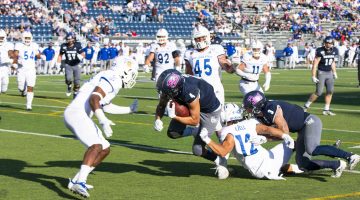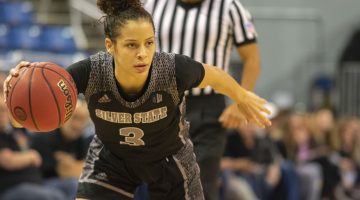
Marcus Lavergne/Nevada Sagebrush
Nevada wide receiver Wyatt Demps (19) takes a knee after Nevada’s 23-17 loss to UNLV at Mackay Stadium on Saturday, Oct. 3. Nevada football has a 6-5 record after giving up a 27-7 lead in the third quarter against the Utah State Aggies last Saturday, Nov. 21.
As I reclined in my cosy, soft black easy chair last Saturday afternoon, I got a message from a friend of mine informing me that Nevada was “smacking” Utah State and that I was completely unfaithful in the Pack’s ability to win games. It was true that Nevada had a nice 27-7 lead with 14:10 left in the third quarter, and James Butler just reeled off a 60-yard touchdown run to push the sophomore running back’s rushing yards over 1000 yards. Texts and calls from other friends blew up my phone, saying that Nevada had a chance to host the Mountain West championship with Boise State losing to Air Force and if San Diego State lost to UNLV later that night. Even though it was exciting to think of hosting the conference championship game at Mackay Stadium, I was hesitant.
From that point on, I watched in amazement as Nevada pulled off a collapse of epic proportions. The downfall hit its climax in the form of a muffed snap at Nevada’s own one-yard line recovered by the Aggies for the go-ahead touchdown. The Nevada faithful watched in horror as the Pack fell 31-27 in one of the more heart-breaking losses in recent memory. Fans took to Twitter to voice their displeasure and frustrations about the game and the season as a whole, but should fans honestly be surprised? If you have followed Nevada football, then you’ll know that this season is business as usual. A projected 6-6 record and a lower-tier bowl berth is what the season will come to. 2015 is an average season and Nevada fans shouldn’t have expected anything different.
As many Wolf Pack fans know, the stereotypical football season is as follows: beat an FCS team or lose big to either one or two ranked teams to start September, win half of its weaker WAC or Mountain West conference games in October, drop key games to tougher conference foes like SDSU or Fresno State in November, lose to Boise State in either a blowout or a heartbreaking close call, have at least one 1000-yard rusher, qualify for and then lose the bowl game and finish the season with around 6-8 wins. For years now, Nevada football has followed different variations of this same script with only the occasional exception. If you don’t believe me, maybe you’ll believe the numbers. Here are some crunched statistics from the 2000-2015.
FCS Teams
Nevada is 9-0 against FCS teams in September.
Ranked opponents
Nevada is 1-24 against ranked opponents.
October
Nevada is a combined 31-32 in the month of October.
SDSU and Fresno
Nevada is a combined 7-13 against both SDSU and Fresno (1-3 vs. SDSU and 6-10 vs. Fresno State).
November
Nevada is 32-27 in the month of November.
Boise State
Nevada is 1-13 against Boise State.
1000-yard rushers
Nevada has had 16 1000-yard rushers and running back Don Jackson is 33 yards away from reaching 1000 this season. James Butler reached 1000 yards against Utah State last Saturday.
Bowl games
Nevada has qualified for a bowl game in 10 of the last 11 seasons, but has a dismal 2-7 record.
Final record
The winning percentage for Nevada over the past 15 seasons has been .518. That’s a slightly winning record.
Winning half of your games isn’t good, but it isn’t bad. It’s just average. Nevada is, and will continue to be, average. Why? It’s all about the Benjamins, baby. Nevada can’t contend with the other power Mountain West schools because they have more money invested into their programs. Take out Nevada and UNLV and the average Mountain West athletic budget was 38.8 million dollars last season, where as Nevada’s is around 24.8 (14 million dollars less). It is clear that the state of Nevada doesn’t support athletics. In 2014-2015, athletics got 4.99 million dollars from Nevada’s $226.85 million state-appropriated funds. Not exactly a recipe for success.
Fans have all the reason in the world to be disappointed in the loss last Saturday against Utah State. It was a collapse of epic proportions that made new fans upset and confirmed the older fans’ cynicism. To the newer fans who are upset about how this season has gone, you haven’t followed the program long enough to realize that this is who Nevada is. Six or seven wins and a mediocre bowl game is the benchmark. Two seasons are the exception: 2005 and 2010. Both years Nevada won a share of the WAC championship and had major success, but those are not the norm. Both of those seasons were anything but normal. In 2005, former head coach Chris Ault introduced his very own pistol offense and had future NFL fifth round quarterback Jeff Rowe lead the team to nine wins. In 2010, the stars aligned for a magical 13-1 season that lead to another WAC championship and the biggest win in program history with an overtime victory over No. four ranked Boise State. In case you were wondering, that is the lone win over a ranked opponent in the past 15 seasons. Future NFL quarterback and program legend Colin Kaepernick was tearing up the record books and leaving a void that was briefly filled by Cody Fajardo.
Until Nevada athletics gets more funding, I don’t expect anything less than what this season has come down to. Say it with me, “Nevada hosting the Mountain West championship.” Does that sound right to you? Based on the evidence, it shouldn’t. Nevada is nothing more than average and don’t expect that to change anytime soon.
Neil Patrick Healy can be reached at neil@sagebrush.unr.edu and on Twitter @NP_Healy.












